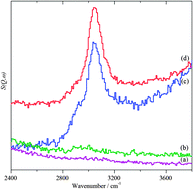In situ spectroscopic investigation of oxidative dehydrogenation and disproportionation of benzyl alcohol†
Abstract
In the

- This article is part of the themed collection: Interfacial Phenomena in (De)hydrogenation Reactions
Maintenance work is planned for Wednesday 1st May 2024 from 9:00am to 11:00am (BST).
During this time, the performance of our website may be affected - searches may run slowly and some pages may be temporarily unavailable. If this happens, please try refreshing your web browser or try waiting two to three minutes before trying again.
We apologise for any inconvenience this might cause and thank you for your patience.
* Corresponding authors
a
Cardiff Catalysis Institute, School of Chemistry, Cardiff University, Cardiff, UK
E-mail:
hutch@cardiff.ac.uk
Fax: +44 (0)2920-874-030
b Inorganic Chemistry and Catalysis, Debye Institute for Nanomaterials Science, Utrecht University, 3584 CG Utrecht, The Netherlands
c ISIS Facility, STFC Rutherford Appleton Laboratory, Chilton, Didcot Oxon OX11 0QX, UK
d Department of Chemistry, Liverpool University, Liverpool, UK
In the

 Please wait while we load your content...
Something went wrong. Try again?
Please wait while we load your content...
Something went wrong. Try again?
E. Nowicka, J. P. Hofmann, S. F. Parker, M. Sankar, G. M. Lari, S. A. Kondrat, D. W. Knight, D. Bethell, B. M. Weckhuysen and G. J. Hutchings, Phys. Chem. Chem. Phys., 2013, 15, 12147 DOI: 10.1039/C3CP50710F
This article is licensed under a Creative Commons Attribution 3.0 Unported Licence. You can use material from this article in other publications without requesting further permissions from the RSC, provided that the correct acknowledgement is given.
Read more about how to correctly acknowledge RSC content.
 Fetching data from CrossRef.
Fetching data from CrossRef.
This may take some time to load.
Loading related content
